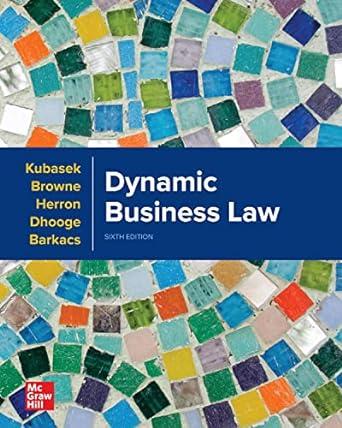In September 2012, Dan Horton d/b/a Heritage Footwear filed a complaint in the Alabama district court alleging
Question:
In September 2012, Dan Horton d/b/a Heritage Footwear filed a complaint in the Alabama district court alleging that Keith Sharp d/b/a Pegasus Partners had failed to pay certain invoices for services that Heritage Footwear had provided to Pegasus. After Sharp failed to appear, the district court entered a default judgment against Sharp and awarded Horton \($9,577.40.
In\) February 2013, Horton obtained a writ of execution regarding three knitting machines and a forklift in Pegasus’ possession. Sharp filed a motion to quash the writ of execution and claimed Horton failed to comply with the requirements of Alabama law with respect to writs of execution. The district court denied this motion, and Sharp appealed to the circuit court.
The circuit court held a de novo trial in February 2016. At the trial, Horton testified that, on the writ-of-execution form, he had checked the box next to “Restore the property to Dan Horton” although he never took physical possession of the property. Horton also testified he had the knitting machines transported to a warehouse where they were sold in an unadvertised sale to Ron Prestwood for \($16,000,\) an amount greater than the total judgment amount. Horton testified he had kept the entire \($16,000\) and the forklift. Horton also testified he did not know if he had signed documents relating to the enforcement of the writ of execution. Sharp argued that, because the execution was irregular, the writ of execution should be quashed. However, the circuit court entered a judgment denying the petition to quash the writ of execution, and Sharp appealed to the Alabama Court of Civil Appeals.
JUDGE MOORE Sharp argues that the circuit court erred in declining to quash the writ of execution because of multiple statutory violations that, Sharp contends, Horton committed during the execution process. Specifically, Sharp argues that Horton personally seized the property and that he failed to make a “return of execution” in violation of Ala. Code 1975, § 6-9-80, that Horton “transported the property away from the neighborhood where it was seized and sold it at another location in violation of Ala. Code 1975, § 6-9-86, that Horton “did not advertise the sale as required by Ala. Code 1975, § 6-9-87, and that Horton did not return the excess money or property to Sharp in violation of Ala. Code 1975, § 6-9-93.
Section 6-9-147, Ala. Code 1975, provides that “[c]ourts have full power over their officers making execution or judicial sales, and whenever satisfied that a sale made under any legal process is infected with fraud, oppression, irregularity, or error to the injury of either party, the sale will be set aside.”
In response to Sharp’s argument, Horton points out that our supreme court has held “that procedural irregularities alone are not enough to invalidate the sale.”
Hogan v. Carter, 431 So.2d 1160, 1163 (Ala. 1983). In the present case, the evidence is undisputed that the violations go beyond mere procedural irregularities and do, in fact, involve injury to Sharp. Indeed, the evidence indicates that Horton completely disregarded the applicable statutory requirements for the conduct of the sale. For example, Horton did not simply give insufficient notice of the sale; instead, he did not attempt to provide notice of the sale or to conduct a statutorily compliant sale. Moreover, Horton retained property and retained the proceeds from the sale above the amount of the judgment. We conclude that the undisputed evidence indicates that the sale in this case was infected with irregularity and error to the injury of Sharp. Therefore, the circuit court erred.
CRITICAL THINKING:
What requirements were disregarded in Horton’s handling and sale of the collateral? How did the court define “procedural irregularities” and apply this definition to Horton’s conduct?
ETHICAL DECISION MAKING:
What conclusions do you reach when analyzing Horton’s behavior from an ethical standpoint? Was this behavior a good-faith effort to obtain satisfaction of the outstanding judgment or an attempt to take advantage of an individual already in default with the court? What are the reasons for your conclusions?
Step by Step Answer:

Dynamic Business Law
ISBN: 9781260733976
6th Edition
Authors: Nancy Kubasek, M. Neil Browne, Daniel Herron, Lucien Dhooge, Linda Barkacs





